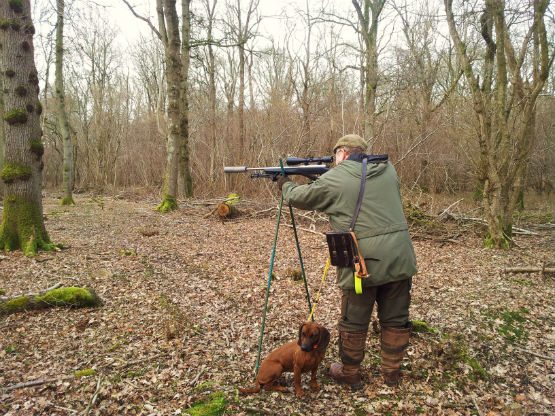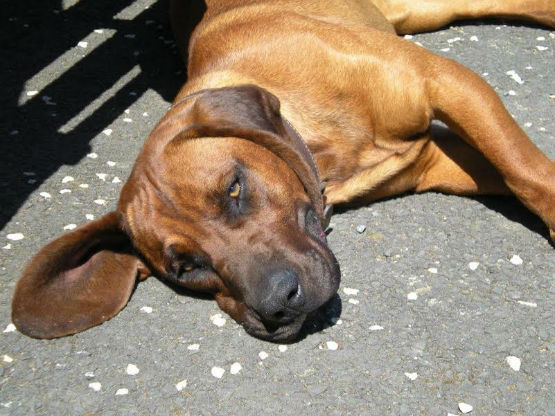In the first of a series of articles, Oliver Siddall looks at the role of Dogs in Deer Management.

Dogs have long been part of our sporting heritage. It may be flushing and retrieving game, dogging in around a shoot, tracking animals or even just providing company to their owners, but these animals undoubtedly provide us with a resource that is second to none. It is believed that dogs have been used for their scenting abilities for over 1000 years.
For both the recreational stalker and the professional stalker alike, dogs can be an invaluable asset. Across Europe, and beyond, dogs are used as a matter of course when it comes to tracking and locating deer that are both alive and those that have been shot and have fallen out of sight. They are also regularly used to follow up after wounded animals, whether they have been shot, injured by dogs or hit by cars.
Over the past few years the use of dogs for deer has seen an upsurge in popularity in the UK. There are now several organisations that offer membership and continual training and accreditation to similar levels then the clubs found across countries such as Germany and Denmark.
Breeds

German Shorthaired Pointers (GSP), German Wirehaired Pointers (GWP), Labradors, Bavarian Schweisshund and Dachshunds are some of the most common dogs found working on deer in the UK. In reality, and despite common misconceptions, most dogs can be used to track deer. However, when selecting a dog it is important to consider the following points:
Does the dog display a desire to track?
Is the breed known for having good levels of concentration?
Does the dog show an ability to find game?
Does the dog have some natural aggression?
Is the dog capable of working alone and with little guidance from the handler?
The majority of these points may seem obvious but they are all vitally important. I have mentioned aggression and it is worth noting that this is an integral part of a dog’s mentality. I am not talking about aggression towards humans or handlers. All dogs have some form of natural aggression. A spaniel trained to pick up pheasants must have enough aggression to pick a bird that is still alive and a dog that is trained on deer must have a similar drive.
Working your dog
I have deliberately avoided focussing on training, puppy selection and equipment for the time being, as I will be covering this in the coming weeks. As a brief overview dogs are worked in four different ways. On a lead or extended line, free reporting, ‘Torvebeller’ and‘Bringsel’. Many countries allow trained and accredited trackers to track deer across land not owned by them in order that they can be dispatched humanely. In the UK this is generally not permitted and as such free running dogs using GPS tracking collars to locate them is not common practice, this has the knock on effect that ‘Torvebeller’ and‘Bringsel’ are also less common.
Torvebeller involves training the dog to howl or bark when it has found the deer, while Bringsel is the dog returning to the handler, holding a piece of leather in its mouth that has previously been attached to his collar. The dog takes hold of the leather when it has found the deer and returns to the handler. This essentially mimics the dogs retrieving instinct and for this to work the dog must be 100% proficient at retrieving. Free reporting relies on the handler’s ability to read the dog when it returns to him/her. Signs such as blood and hair around the mouth are key indicators that a deer has been found.
Far more common is tracking using leads, a technique that is widely used by the police and other search dog handlers. This involves fitting the dog with a tracking collar or harness and then allowing the dog to work on the end of a long line. This method means that the dog is always in touch with the hander and can be kept close if working next to roads and railways for example. This technique will be more widely explained over the next few weeks and will form the basis of many of the training exercises I will recommend to you.
In the vast majority of cases a deer will be found within 100m of the location it was shot. We all know that although this could be a flat grassy field with excellent vehicular access, it is more likely to be a dark and dense bramble patch, and probably the only one for miles! Obviously this makes finding the deer harder and it is where a dog can save precious minutes, especially if the light is fading fast. We all hope that we never have to track a deer that has been injured but we must be prepared. An injured deer will naturally head for cover if there is any available, this makes it vital that we have the correct resources to hand. We all have a responsibility to ensure that we give maximum effort to locating animals we have shot and that this is done quickly, calmly and efficiently.
I am aware that not everyone has time to own and train their own dog, but there are things we can all do to ensure we are in a position to deal with any issues we may have when out stalking. If possible I would recommend having the number of someone with a dog on your phone. If you don’t know anyone then there are organisations that offer the service. I always carry tape and glow sticks to mark blood trails and shot locations. This will greatly help a handler coming to assist, and I would suggest you mark these sites, even if you are working a dog yourself. It is easy to become disorientated when you are surrounded by trees!
Look out for further articles from Oliver in the coming weeks. In the mean time if you'd like to read more about the 'Joy of a Deer Dog' follow this link to an article by Ayrshire Stalking's Chris Dalton: the-joys-of-a-deer-dog
 (Left: Oliver Siddall works closely with Kent Police Dog Unit and has recently joined the County Deer Stalking team.
(Left: Oliver Siddall works closely with Kent Police Dog Unit and has recently joined the County Deer Stalking team.
Oliver is a Registered Firearms Dealer and qualified Range Conducting Officer. He is also a keen Deer Stalker and holds both a DSC1 and BDS Deer Management Qualification).



















